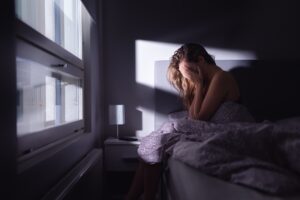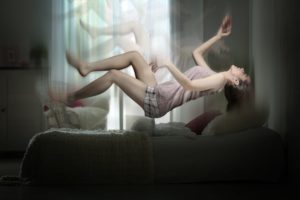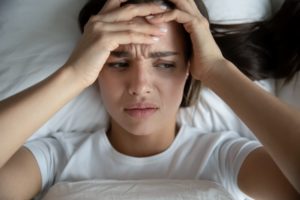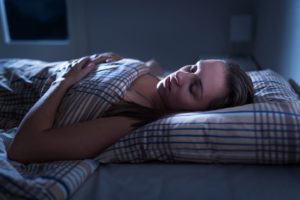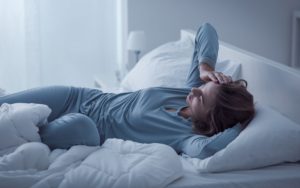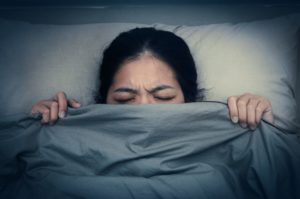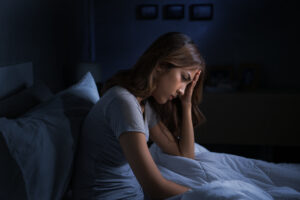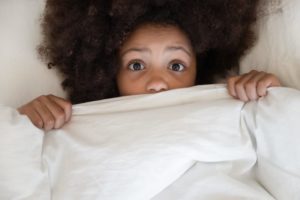When you buy through our links, we may earn a commission. Products or services may be offered by an affiliated entity. Learn more.
Sexsomnia: What to Know About Sleep Sex
- Symptoms: Sexsomnia is a sleep disorder characterized by engaging in sexual activities during sleep.
- Causes: The causes of sexsomnia are not entirely clear but may be related to other sleep disorders and external factors like stress and alcohol use.
- Diagnosis: A sleep study may help diagnose sexsomnia or identify another sleep disorder or medical condition associated with sexsomnia.
- Treatment: Sexsomnia treatment depends on the underlying cause but often includes taking medication, improving sleep hygiene, and reducing stress or triggers.
Sexsomnia is a rare and often misunderstood sleep disorder in which a person engages in sexual behaviors while asleep. It can cause considerable distress and shame both for people who have it and their partners. However, treatment is possible and may include the use of medications or lifestyle changes, depending on the underlying cause.
What Is Sexsomnia?
Sexsomnia, also known as sleep sex, is a type of sleep disorder known as a parasomnia. Parasomnias refer to unusual sensations and behaviors, like sleepwalking, that people may experience or exhibit while asleep, falling asleep, or waking up.
In the case of sexsomnia, people engage in sexual behaviors such as masturbation, sexual movements, sexual aggression, or initiating sex with another person. Though a sleeper’s eyes may be open and they may make sexual noises, they are asleep during these activities and unaware of their behavior once they’re awake.
It’s difficult for experts to estimate how many people experience sexsomnia. The disorder can occur unexpectedly, and a person may not know they experience it unless another person witnesses it and tells them. However, nearly 8% of people at a sleep center exhibited symptoms of the disorder.
What Are the Symptoms of Sexsomnia?
The symptoms of sexsomnia vary depending on the person, but the underlying feature of this parasomnia is that a sleeping person exhibits sexual behaviors that they are unaware of and unable to control. These behaviors can include :
- Masturbation
- Fondling
- Sexual noises
- Sexual movements
- Initiating sexual activities
- Sexual aggression
- Sexual assault
Sexsomnia can occur alongside other parasomnias, like sleepwalking and sleep talking. The disorder can be up to three times more common in men than in women. Masturbation is the most common behavior in women with sexsomnia.
In addition to the sexual behaviors, signs that someone is acting under the influence of a sexual parasomnia include:
- Unresponsiveness or minimal responsiveness to conversation or the environment
- Unusual sexual responses or aggression
- Inability to be woken or difficulty being woken
- No memory of their sexual behaviors once awake
- Trauma to the genitals, often due to abrasion
What Causes Sexsomnia?
Commonly, sexsomnia is a type of confusional arousal, or a partial awakening from non-rapid eye movement (NREM) sleep. During an NREM confusional arousal, a person appears to wake from deep sleep but is confused and may forget what they say or do. Confusional arousals can last several minutes and often result in the person going back to sleep again.
Research into the causes of sexsomnia remains limited, but experts have found that it’s associated with a wide range of underlying conditions. These include:
- Other parasomnias, such as sleepwalking
- Sleep-related seizures or epilepsy
- REM sleep behavior disorder
- Obstructive sleep apnea
- Kleine-Levin syndrome
- Chronic insomnia
- Restless legs syndrome
- Narcolepsy
- Persistent sexual arousal syndrome
- Sleep-related dissociative disorders
- Nocturnal psychotic disorders
- Bruxism (teeth grinding)
Risk Factors and Triggers
In addition to underlying disorders, other factors may trigger sexsomnia or increase a person’s risk of experiencing it. These risk factors and triggers include:
- Sleep deprivation
- Alcohol use
- Stress or anxiety
- Depression
- Recreational drug use
- Circadian rhythm disruption, such as jet lag
- Making physical contact with another person during sleep
How Is Sexsomnia Diagnosed?
Most people who experience symptoms of sexsomnia don’t report them to their doctor. Shame is a common factor among people with this disorder, but it’s important to remember that sexsomnia is often treatable, and medical professionals have your health and safety in mind.
Symptom Review
If you’re worried that you might have sexsomnia, speaking to a medical professional is the first step in diagnosis and treatment. Your doctor or sleep specialist will likely ask you questions about your sleep history and any incidents of sexsomnia, sleepwalking, or other parasomnias.
To prepare for the visit, ask anyone who has been near you while you were sleeping if they’ve witnessed symptoms. For example, ask your bed partner, roommate, or family members if they’ve seen you make movements or heard you make sounds during the night after going to sleep.
Sleep Study
Your doctor may recommend a recorded sleep study, or video-polysomnography, in order to see if you have sexsomnia or underlying sleep disorders. A sleep study measures muscle movements and records video of the sleeper, so it can identify if and when sexsomnia occurs during the study. However, not everyone experiences sexsomnia symptoms every night, so the study might not pick it up.
Sleep studies also monitor breathing and identify cases of sleep apnea, a potential underlying trigger of sexsomnia for some people. A sleep study also often includes an electroencephalogram (EEG), which can identify seizures. If nighttime seizures are present, they may be the underlying cause, and treating the seizures may also successfully treat the sexsomnia.
What Are the Treatments for Sexsomnia?
Treatment for sexsomnia depends on the underlying cause. Because sexsomnia can be caused by a range of conditions, your doctor may offer treatment options related to your unique circumstances. They may also suggest lifestyle changes to avoid potential triggers and steps to ensure your safety and the safety of others in your home until the condition is managed.
Medication
A few medication types are commonly prescribed for sexsomnia. These include:
- Benzodiazepines: In one review, a benzodiazepine called clonazepam was found to successfully treat sexsomnia in 90% of people who have it.
- Anticonvulsant therapy: That same review found that, among five people who had sexsomnia caused by sleep-related seizures, all improved in response to anticonvulsant therapy.
- Antidepressants: Case studies have found that antidepressants can successfully treat sexsomnia in some people. Antidepressants used including tricyclics, selective serotonin reuptake inhibitors (SSRIs), and serotonin-norepinephrine reuptake inhibitors (SNRIs).
Continuous Positive Airway Pressure (CPAP)
Sexsomnia associated with other sleep disorders is usually relieved by treating the underlying problem, such as the use of CPAP machine or a mandibular advancement device for obstructive sleep apnea.
Lifestyle Changes
Certain lifestyle changes and sleep hygiene practices have been shown to help people with parasomnias. These include:
- Limiting or avoiding alcohol, especially before bedtime
- Going to sleep and waking up at the same time every day, even on weekends
- Getting an adequate amount of sleep, which is 7 to 9 hours per night for most people
- Developing a calming bedtime routine to prepare for sleep
- Avoiding digital devices, like phones, tablets, computers, and TVs, in the hours before bed
- Managing stress and anxiety
- Engaging in relaxation techniques, like mindfulness, meditation, or yoga
Therapy
Receiving a diagnosis and appropriate medical treatment is the first step in coping with sexsomnia. While many people feel shame around their condition, speaking openly and honestly with the people in their life about diagnosis and treatment helps keep everyone safe.
One-on-one or couples therapy may help with processing the impact sexsomnia has on a person’s life or a romantic relationship. Some case reports have shown that hypnosis and cognitive behavioral therapy (CBT) may help reduce sexsomnia symptoms. That said, therapy is usually viewed as a complementary therapy rather than a primary treatment for sexsomnia.
Safety Precautions
As sexsomnia treatment may not be immediately effective, it’s crucial to take safety precautions as necessary. Depending on a person’s situation, this may involve:
- Sleeping in a separate room from a partner
- Avoiding sleeping around strangers or minors
- Locking bedroom doors before sleeping
- Avoiding all known or possible triggers
- Setting movement alarms
Frequently Asked Questions
How do I know if I have sexsomnia?
Talk to your doctor if you suspect you have sexsomnia. People often don’t realize they have sexsomnia until a bed partner tells them about their nighttime sexual behaviors. If you’re unsure, ask a bed partner if they’ve seen you engage in sexual behavior during the night. If you don’t share a bed or bedroom with anyone, you could also consider undergoing a sleep study.
Are wet dreams a form of sexsomnia?
Nocturnal emissions, commonly called “wet dreams,” are not the same thing as sexsomnia. Nocturnal emissions are considered a normal part of male adolescent development and are also experienced by adult men . However, some people with sexsomnia may mistake their condition for nocturnal emissions if their behavior is not witnessed by another person.
Are your eyes open during sexsomnia?
Researchers haven’t explicitly studied how common it is for a person to have their eyes open during sexsomnia. However, studies have shown many instances of sexsomnia are forms of NREM confusional arousals, and people tend to have their eyes open during a confusional arousal. That said, it’s also possible a person could have their eyes closed, if the sexsomnia stems from a different cause.

Still have questions? Ask our community!
Join our Sleep Care Community — a trusted hub of sleep health professionals, product specialists, and people just like you. Whether you need expert sleep advice for your insomnia or you’re searching for the perfect mattress, we’ve got you covered. Get personalized guidance from the experts who know sleep best.
References
11 Sources
-
Singh, S., Kaur, H., Singh, S., & Khawaja, I. (2018). Parasomnias: A Comprehensive Review. Cureus, 10(12), e3807.
https://pubmed.ncbi.nlm.nih.gov/30868021/ -
McCann, K. (2010, May 12). Study finds that sexsomnia is common in sleep center patients. American Academy of Sleep Medicine.
https://aasm.org/study-finds-that-sexsomnia-is-common-in-sleep-center-patients/ -
Schenck, C. H., Arnulf, I., & Mahowald, M. W. (2007). Sleep and sex: What can go wrong? A review of the literature on sleep related disorders and abnormal sexual behaviors and experiences. Sleep, 30(6), 683–702.
https://pubmed.ncbi.nlm.nih.gov/17580590/ -
Trajanovic, N. N., Mangan, M., & Shapiro, C. M. (2007). Sexual behaviour in sleep: An internet survey. Social Psychiatry and Psychiatric Epidemiology, 42(12), 1024–1031.
https://pubmed.ncbi.nlm.nih.gov/17932612/ -
Dubessy, A.-L., Leu-Semenescu, S., Attali, V., Maranci, J.-B., & Arnulf, I. (2017). Sexsomnia: A specialized non-rem parasomnia? Sleep, 40(2).
https://pubmed.ncbi.nlm.nih.gov/28364495/ -
Wieckiewicz, M., & Winocur, E. (2020). Special issue: Sleep bruxism-The controversial sleep movement activity. Journal of Clinical Medicine, 9(3), 880.
https://pubmed.ncbi.nlm.nih.gov/32210201/ -
Kumar V, Grbach VX, Castriotta RJ. Resolution of sexsomnia with paroxetine. J Clin Sleep Med. 2020;16(7):1213-1214. doi:10.5664/jcsm.8478
https://pubmed.ncbi.nlm.nih.gov/32672534/ -
Khawaja, I. S., Hurwitz, T. D., & Schenck, C. H. (2017). Sleep-related abnormal sexual behaviors (sexsomnia) successfully treated with a mandibular advancement device: A case report. Journal of Clinical Sleep Medicine: JCSM: Official Publication of the American Academy of Sleep Medicine, 13(4), 627–628.
https://pubmed.ncbi.nlm.nih.gov/28095975/ -
Drakatos, P., Marples, L., Muza, R., Higgins, S., Gildeh, N., Macavei, R., Dongol, E. M., Nesbitt, A., Rosenzweig, I., Lyons, E., d’Ancona, G., Steier, J., Williams, A. J., Kent, B. D., & Leschziner, G. (2019). NREM parasomnias: A treatment approach based upon a retrospective case series of 512 patients. Sleep Medicine, 53, 181–188.
https://pubmed.ncbi.nlm.nih.gov/29753639/ -
Gul, A., Yuruk, E., & Serefoglu, E. C. (2020). Frequency of nocturnal emissions and masturbation habits among virgin male religious teenagers. Revista Internacional De Andrologia, 18(1), 21–26.
https://pubmed.ncbi.nlm.nih.gov/30606622/ -
Meng, X., Fan, L., Liu, J., Wang, T., Yang, J., Wang, J., Wang, S., & Ye, Z. (2013). Fresh semen quality in ejaculates produced by nocturnal emission in men with idiopathic anejaculation. Fertility and Sterility, 100(5), 1248–1252.
https://pubmed.ncbi.nlm.nih.gov/23987518/




